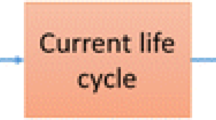Abstract
Goal, Scope and Background
In the recently published (Dutch) Handbook on LCA, economic allocation is advised as baseline method for most allocation situations in a detailed LCA. Although the Handbook on LCA aimed to provide a ‘cookbook’ with operational guidelines for conducting each step of an LCA, this was not completely achieved for the allocation step. The guidelines for allocation largely remained at the level of principles. This restricted elaboration of economic allocation may hamper application in practice. Therefore, this paper elaborates some examples applying economic allocation.
Method
Two concepts are of particular importance when applying economic allocation: functional flow and multi-functional process. The definitions of these concepts are presented and discussed. The basic principle of economic allocation is that having determined the various functional flows of a multi-functional process, all other flows need to be allocated to these functional flows according to their shares in the total proceeds. Proceeds are based on prices and these are not always easy to determine for a process. A summary of possible solutions for different problems when determining prices is given.
Results and Discussion
The examples presented focus on co-production and various recycling situations. All examples are hypothetical in order to avoid discussions on the data. The examples show that the prices of the functional flows determine the allocation results. It is of importance to have correct information on the relative prices of the functional flows at stake, especially whether they are negative or positive. Learning from these examples, we establish a decision tree for economic allocation. The decision tree is meant for identifying and handling multi-functionality situations starting from a defined (product) system. This decision tree is with minor adaptations also applicable to other allocation methods and has a more general value than for the economic allocation method only.
Conclusions and perspective
The examples have helped us to establish a decision tree for handling the multi-functionality problem by economic allocation. The examples can be broadened to other materials and allocation situations. We would encourage others to provide other examples and experiences as we expect that these will help to further improve and refine the guidelines and decision tree for economic allocation in future.
Similar content being viewed by others
References
Guinée JB (Ed.), Gorrée M, Heijungs R, Huppes G, Kleijn R, Wegener Sleeswijk A, Udo de Haes HA, de Bruijn JA, van Duin R, Huijbregts MAJ (2002): Handbook on Life Cycle Assessment: Operational Guide to the ISO Standards. Kluwer Academic Publishers. Dordrecht (Hardbound, ISBN 1-4020-0228-9; Paperback, ISBN 1-4020-0557-1; see also http://www.kap.n1/prod/h/l -4020-0228-9)
Guinée JB (2001): Handbook on Life Cycle Assessment — Operational Guide to the ISO Standards. Int J LCA 6 (5) 255
Heijungs {GNR}, Frischknecht {GNR} (1998): A Special View on the Nature of the Allocation Problem. Int J LCA 3 (6) 321–332
Heijungs R, Suh S (2002): The Computational Structure of Life Cycle Assessment. Kluwer Academic Publishers, Dordrecht
Huppes G (1993): Macro-environmental policy — principles and design. Elsevier, Amsterdam
ISO International Standard 14041 (1998E): Environmental management — Life cycle assessment — Goal and scope definition and Inventory analysis. International Organisation for Standardisation (ISO), Geneva
Koutsoyiannis A (1980): Modern microeconomics (second edition). MacMillan Press, London
Vogtländer JG, Brezet HC, Hendriks CF (2001): The Virtual Eco-Costs ’99 — A Single LCA-Based Indicator for Sustainability and the Eco-Costs — Value Ratio (EVR) Model for Economic Allocation. Int J LCA 6 (3) 157–166
Weidema BP (2001): Avoiding co-product allocation in life-cycle assessment. J Ind Ecol 4 (3) 39–61
Werner F, Richter K (2000): Economic Allocation in LCA — A Case Study About Aluminium Window Frames. Int J LCA 5 (2) 79–83
Author information
Authors and Affiliations
Corresponding author
Rights and permissions
About this article
Cite this article
Guinée, J.B., Heijungs, R. & Huppes, G. Economic allocation: Examples and derived decision tree. Int J LCA 9, 23–33 (2004). https://doi.org/10.1007/BF02978533
Received:
Accepted:
Issue Date:
DOI: https://doi.org/10.1007/BF02978533




